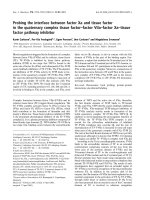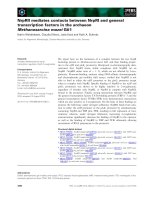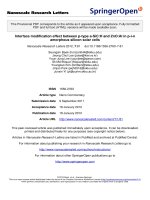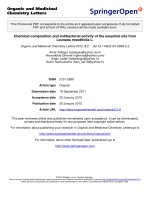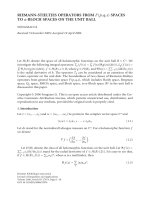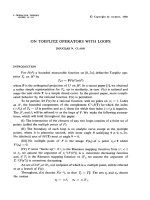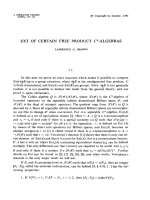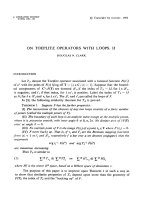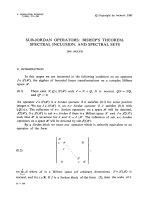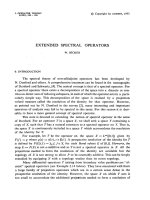Báo cáo toán học: "Weighted Composition Operators between Different Weighted Bergman Spaces in Polydiscs " pot
Bạn đang xem bản rút gọn của tài liệu. Xem và tải ngay bản đầy đủ của tài liệu tại đây (137.22 KB, 10 trang )
Vietnam Journal of Mathematics 34:3 (2006) 255–264
Weighted Composition Operators
Between Different Weighted Bergman
Spaces in Polydiscs
Li Songxiao
*
Department of Math., Shantou University,515063, Shantou, Guangdong, China
and Department of Mathematics, Jiaying University,
514015, Meizhou, Guangdong, China
Received April 04, 2004
Revised September 18, 2005
Abstract. Let D
n
be the unit polydiscs of C
n
, ϕ(z)=(ϕ
1
(z), ,ϕ
n
(z)) be a holomor-
phic self-map of
D
n
and ψ(z) a holomorphic function on D
n
. Necessary and sufficient
conditions are established for the weighted composition operator
ψC
ϕ
induced by ϕ(z)
and ψ(z) to be bounded or compact between different weighted Bergman spaces in
polydiscs.
2000 Mathematics Subject Classification: 47B38, 32A36.
Keywords: Bergman space, polydiscs, weighted composition operator.
1. Introduction
We adopt the notation described in [4-6]. Denote by D
n
the unit polydisc in
C
n
,byT
n
the distinguished boundary of D
n
,byA
p
α
(D
n
) the weighted Bergman
spaces of order p with weights
n
i=1
(1−|z
i
|
2
)
α
, α>−1. We use m
n
to denote the
n-dimensional Lebesgue area measure on T
n
, normalized so that m
n
(T
n
)=1.
By σ
n
we shall denote the volume measure on D
n
given by σ
n
(D
n
) = 1, and
by σ
n,α
we shall denote the weighted measure on D
n
given by σ
n,α
=
n
i=1
(1 −
|z
i
|
2
)
α
σ
n
.IfR is a rectangle on T
n
, then S(R) denote the corona associated to
∗
The author is partially supported by NNSF(10371051) and ZNSF(102025).
256 Li Songxiao
R. In particular, if R = I
1
× I
2
×···×I
n
⊂ T
n
, with I
i
being the intervals on
T
n
of length δ
i
and centered at e
i(θ
0
i
+δ
i
/2)
for i =1, ···,n, then S(R) is given by
S(R)=S(I
1
) × S(I
2
) ×···×S(I
n
), where
S(I
i
)={re
iθ
∈ D :1− δ
i
<r<1,θ
i
0
<θ<θ
0
i
+ δ
i
}.
For α>−1, 0 <p<∞, recall that the weighted Bergman space A
p
α
(D
n
)
consists of all holomorphic functions on the polydisc satisfying the condition
f
p
A
p
α
=
D
n
|f(z)|
p
n
i=1
(1 −|z
i
|
2
)
α
dσ
n,α
< +∞.
Denoted by H(D
n
) the class of all holomorphic functions with domain D
n
.
Let ϕ be a holomorphic self-map of D
n
, the composition operator C
ϕ
induced by
ϕ is defined by (C
ϕ
f)(z)=f(ϕ(z)) for z in D
n
and f ∈ H(D
n
). If, in addition,
ψ is a holomorphic function defined on D
n
, the weighted composition operators
ψC
ϕ
induced by ψ and ϕ is defined by
(ψC
ϕ
f)(z)=ψ(z)f(ϕ(z))
for z in D
n
and f ∈ H(D
n
).
It is interesting to characterize the composition operator on various analytic
function spaces. The b ook [2] contains plenty of information. It is well known
that composition operator is bounded on the Hardy space and the Bergman space
in the unit disc. This result do es not carry over to the case of several complex
variables. Singh and Sharma has showed in [7] that not every holomorphic
map from D
n
to D
n
induces a composition operator on H
p
(D
n
). For example,
ϕ(z
1
,z
2
)=(z
1
,z
2
) does not induce a bounded composition operator on H
2
(D
n
).
Jafari studied the composition operator on Bergman spaces A
p
α
(D
n
) in [6].
His results can be stated as follows.
Theorem A. Let 1 <p<∞,α > −1 and let ϕ be a holomorphic self-map
of D
n
. Define µ to be µ(E)=σ
n,α
(ϕ
−1
(E))(E ⊂ D
n
). Then C
ϕ
is bounded
(compact) on A
p
α
(D
n
) if and only if µ is an (compact) α Carleson measure.
Theorem B. Let 1 <p<∞ and α>−1 and let ϕ be a holomorphic self-map
of D
n
. Then
(i) C
ϕ
is a bounded composition operator on A
p
α
(D
n
) if and only if
sup
z
0
∈D
n
D
n
n
i=1
1 −|(z
0
)
i
|
2
|1 − (z
0
)
i
ϕ
i
|
2
2+α
dσ
n,α
≤ M<∞.
(ii) C
ϕ
is a compact composition operator on A
p
α
(D
n
) if and only if
lim sup
z
0
∈D
n
D
n
n
i=1
1 −|(z
0
)
i
|
2
|1 − (z
0
)
i
ϕ
i
|
2
2+α
dσ
n,α
=0
as z
0
→1.
In this paper, we study the weighted composition operators between differ-
ent weighted Bergman spaces in polydiscs. Some measure characterizations and
Weighted Composition Operators Between Different Weighted Bergman Spaces 257
function theoretic characterizations are given for the boundedness and compact-
ness of the weighted composition operators.
Throughout the remainder of this paper C will denote a positive constant,
the exact value of which may vary from one appearance to the next.
2. Measure Characterization of Weighted Composition Operators
In this section, we give the measure characterization of weighted composition
operators between different weighted Bergman spaces. For this purpose, we
should need some lemmas which will be stated as follows.
Definition 1. A finite, nonnegative, Borel measure µ on D
n
is said to be a
η − α Carleson measure if
µ
1
η
(S(R)) ≤ C
n
i=1
δ
2+α
i
for all R ⊂ T
n
.
µ is said to be a compact η − α Carleson measure if
lim
δ
i
→0
sup
θ∈T
n
µ
1
η
(S(R))
n
i=1
δ
2+α
i
=0.
Remark. When η = 1, the definition of Carleson measures for polydiscs is due
to Chang(see [1]).
Modifying the proof of Theorem 2.5 in [5], we get the following lemma.
Lemma 1. Suppose that 1 <p<∞, α>−1,η ≥ 1.LetI be the identity
operator from A
p
α
(D
n
) into L
ηp
(D
n
,µ). Then I is a bounded operator if and
only if µ is an η − α Carleson measure.
Proof. We prove that if f ∈ A
p
α
(D
n
) then
D
n
|f|
ηp
dµ
1
η
≤ C
D
n
|f|
p
dσ
n,α
(1)
if and only if
µ
1
η
(S(R)) ≤ C
n
j=1
δ
α+2
j
. (2)
For this purpose, suppose that (1) holds for all f ∈ A
p
α
(D
n
). Define
f(z)=
n
j=1
(1 − α
j
z
j
)
−(α+2)/p
,
where α
j
=(1−δ
j
)e
i(θ
0
j
+δ
j
/2)
. It is easy to see that f(z) ∈ A
p
α
(D
n
). In addition,
since on S(R),
258 Li Songxiao
|f(z)|
ηp
> 2
−η(α+2)
n
j=1
δ
−η(α+2)
j
,
we have
D
n
|f(z)|
ηp
dµ
1
η
≥
S(R)
|f(z)|
ηp
dµ
1
η
≥ 2
−(α+2)
n
j=1
δ
−(α+2)
j
µ
1
η
(S(R)). (3)
Then the result follows from (1) and (3).
Conversely, suppose that (2) holds for all rectangles in T
n
. Fix z ∈ D
n
and
let 1 −|z
j
|
2
= δ
j
, consider a polydisc W
z
centered at z and of radius δ
j
/2 in the
z
j
coordinate. If R = I
1
× × I
n
is the rectangle on T
n
with I
j
centered at
z
j
/|z
j
| and |I
j
| =2δ
j
, then W
z
⊂ S(R) (see [5]). Therefore for any f ∈ A
p
α
(D
n
),
by the sub mean value property for |f|, we get (see [5])
|f(z)|≤
C
n
j=1
δ
α+2
j
S(R)
|f|dσ
n,α
.
Since σ
n,α
(S(R)) = C
n
j=1
δ
α+2
j
, then
|f(z)|≤
C
σ
n,α
(S(R))
S(R)
|f|dσ
n,α
. (4)
Now define
M(f) = sup
R
1
σ
n,α
(S(R))
S(R)
|f|dσ
n,α
.
We get
|f(z)|≤CM(f)(z). (5)
We will show that there exists a constant C independent of s such that
µ{M(f) >s}≤C(s
−1
f
1,α
)
η
. (6)
Given (6), since M is a sublinear operator of type (∞, ∞), it is obvious that
M(f)
∞
≤f
∞
. If we define
1
p
= θ,
1
q
=
θ
η
, 0 <θ<1, i.e. q = pη, by the
Marcinkiewicz interpolation theorem we obtain that
D
n
|M(f)|
ηp
dµ
1
η
≤ C
D
n
|f|
p
dσ
n,α
. (7)
Combining (5) and (7) we get
D
n
|f(z)|
ηp
dµ
1
η
≤ C
D
n
|M(f)(z) |
ηp
dµ
1
η
≤ C
D
n
|f(z)|
p
dσ
n,α
.
This prove (1).
Weighted Composition Operators Between Different Weighted Bergman Spaces 259
To complete the proof we need to show that if µ
1
η
(S(R)) ≤ Cσ
n,α
(S(R)),
then (6) holds. Let R
z
= I
1
× × I
n
denote rectangle on T
n
with I
j
denoting
intervals centered at z
j
/|z
j
| and of radius (1 −|I
j
|)/2. Let S
z
denote the corona
associated with R
z
. Note that z ∈ S
z
, define
A
s
=
z ∈ D
n
:
S
z
|f|dσ
n,α
>s( + σ
n,α
(S
z
))
. (8)
It is easily to check that the following equality holds
Λ={z ∈ D
n
: M(f) >s} =
>0
A
s
,
i.e. µ(Λ) = lim
→0
µ(A
s
). Furthermore, if z ∈ A
s
and S
z
are disjoint for the
different z ∈ Λ, then by (8) we have
s
z∈Λ
( + σ
n,α
(S
z
)) <
z∈Λ
S
z
|f|dσ
n,α
≤f
1,α
.
Hence
s
z∈Λ
( + σ
n,α
(S
z
)) ≤f
1,α
. (9)
Consider the last inequality (9), it shows that there are only finitely many z ∈
A
s
so that their corresponding S
z
are disjoint. From these extract the points,
z
1
, ,z
l
, that in addition have the property that if their associated S
z
radius
are multiplied by five in each coordinate then the resulting sets cover A
s
. This
follows from covering lemma. Write the S
z
associated with these points as
S
1
,S
2
, ,S
l
. Since A
s
⊂
l
k=1
5S
k
, S
k
are pairwise disjoint,
µ(A
s
) ≤ 5
n
l
k=1
µ(S
k
), (10)
(see [5]). Also, by hypothesis
µ
1
η
(S
k
) ≤ Cσ
n,α
(S
k
), (11)
combining (9), (10) and (11), we get
µ(A
s
) ≤ 5
n
l
k=1
µ(S
k
) ≤ C
l
k=1
( + σ
n,α
(S
k
))
η
≤ C(s
−1
f
1,α
)
η
.
Letting tend to zero we obtain
µ{z ∈ D
n
: M(f) >s}≤C(s
−1
f
1,α
)
η
.
This completes the proof.
Using Lemma 1, we give a characterization of the boundedness of the weighted
composition operator ψC
ϕ
: A
p
α
(D
n
) → A
ηp
β
(D
n
).
Theorem 1. Suppose that 1 <p<∞, β,α > −1,η≥ 1.Letϕ be a holomor-
phic self-map of D
n
and ψ be a holomorphic function on D
n
, dν = |ψ|
ηp
dσ
n,β
,
260 Li Songxiao
µ(E)=ν(ϕ
−1
(E))(E ⊂ D
n
). Then ψC
ϕ
: A
p
α
(D
n
) → A
ηp
β
(D
n
) is bounded if
and only if µ is a η − α Carleson measure.
Proof. If ψC
ϕ
: A
p
α
(D
n
) → A
ηp
β
(D
n
) is bounded, then there exists a constant C
such that
ψf ◦ ϕ
A
ηp
β
≤ Cf
A
p
α
for all f ∈ A
p
α
(D
n
), i.e.
D
n
|ψf ◦ ϕ|
ηp
dσ
n,β
(z)
1
η
≤ C
D
n
|f|
p
dσ
n,α
(z).
By the definition of µ, we have (see [3, p. 163])
D
n
|ψf ◦ ϕ|
ηp
dσ
n,β
=
D
n
|f|
ηp
dµ.
Hence
D
n
|f|
ηp
dµ
1
η
≤ C
D
n
|f|
p
dσ
n,α
(z).
The assertion follows from Lemma 1.
Conversely, suppose that µ is an η−α Carleson measure. By Lemma 1, there
exists a constant C such that
D
n
|f|
ηp
dµ
1
η
≤ C
D
n
|f|
p
dσ
n,α
(z)
for all f ∈ A
p
α
(D
n
). By the definition of µ, ψf ◦ ϕ
A
ηp
β
≤ Cf
A
p
α
. Hence
ψC
ϕ
: A
p
α
(D
n
) → A
ηp
β
(D
n
) is bounded. We are done.
To characterize the compactness of weighted composition operators between
different weighted Bergman spaces, we will need the following lemma, whose
proof is an easy modification of that Proposition 3.11 in [2], we omit the proof.
Lemma 2. Suppose that 1 <p<∞, β, α > −1, η ≥ 1.Letϕ be a holomorphic
self-map of D
n
and ψ be a holomorphic function on D
n
. Then the weighted
composition operator ψC
ϕ
: A
p
α
(D
n
) → A
ηp
β
(D
n
) is compact if and only if for
any bounded sequence {f
k
} converging to zero in A
p
α
(D
n
), ψf
k
◦ ϕ
ηp
ηp,β
→ 0 as
k →∞.
Theorem 2. Suppose that 1 <p<∞, β,α > −1, η ≥ 1.Letϕ be a holomor-
phic self-map of D
n
and ψ be a holomorphic function on D
n
, dν = |ψ|
ηp
dσ
n,β
,
µ(E)=ν(ϕ
−1
(E))(E ⊂ D
n
). Then ψC
ϕ
: A
p
α
(D
n
) → A
ηp
β
(D
n
) is compact if
and only if µ is a compact η − α Carleson measure.
Proof. Suppose ψC
ϕ
: A
p
α
(D
n
) → A
ηp
β
(D
n
) is compact. Let
f
δ
(z
1
,z
2
, ,z
n
)=
n
i=1
δ
β−(α+2)/p
i
(1 − η
i
z
i
)
β
,
Weighted Composition Operators Between Different Weighted Bergman Spaces 261
where 0 <δ
j
< 1, β>(α +2)/p and η
j
=(1− δ
j
)e
i(θ
0
j
+δ
j
/2)
. These functions
are bounded in A
p
α
(D
n
), and tend to zero weakly as δ
i
→ 0. Since on regions
S(R), |1 −
η
i
z
i
| < 2δ
i
, we have
|f
δ
(z
1
,z
2
, ,z
n
)|
p
>
n
i=1
δ
(β−(α+2)/p) p
i
(2
β
δ
β
i
)
p
=
n
i=1
1
δ
α
+2
i
2
pβ
,
then we get
(δ)=ψf
δ
◦ ϕ
ηp
ηp,β
=
D
n
|ψf
δ
◦ ϕ|
ηp
dσ
n,β
≥
D
n
|f
δ
|
ηp
dµ ≥
µ(S(R))
n
i=1
δ
η(α+2)
i
2
ηpβ
,
where (δ) → 0asδ
i
→ 0 for some i. Hence µ
1
η
(S) ≤ (δ)2
nβp
n
i=1
δ
α+2
i
, i.e.
lim
δ
i
→0
sup
θ∈T
n
µ
1
η
(S(R))
n
i=1
δ
α+2
i
=0.
Therefore µ is a compact η − α Carleson measure.
Conversely, suppose that µ is a compact η − α Carleson measure, then for
every >0, there is δ such that
sup
θ∈T
n
µ
1
η
(S(R))
n
i=1
δ
α+2
i
≤
for all δ
i
<δ. Let f
k
⊂ A
p
α
(D
n
) converge uniformly to 0 on each compact subsets
of D
n
. It just only need to show that ψf
k
◦ ϕ
ηp,β
→ 0. We have
ψf
k
◦ ϕ
ηp
ηp,β
=
D
n
|ψf
k
◦ ϕ|
ηp
dσ
n,β
=
D
n
|f
k
|
ηp
dµ
=
D
n
\(1−δ)D
n
|f
k
|
ηp
dµ +
(1−δ)D
n
|f
k
|
ηp
dµ
= I
1
+ I
2
.
Write µ = µ
1
+ µ
2
, where µ
1
is the restriction of µ to (1 − δ)D
n
and µ
2
lies on
the complement of this set in D
n
. Then, since µ
2
≤ µ, we get
sup
µ
2
(S(R))
t
n(α+2)
≤ sup
µ(S(R))
t
n(α+2)
,
where the supremums are extended over all θ ∈ T
n
and for all 0 <t<δ. Then
it is clearly that µ
2
is a compact η − α Carleson measure. Hence
I
1
=
D
n
\(1−δ)D
n
|f
k
|
ηp
dµ ≤ sup
µ
2
(S(R))
t
ηn(α+2)
f
k
ηp
A
p
α
≤ Cf
k
ηp
A
p
α
.
Because {f
k
} converges uniformly to 0 on (1 − δ)D
n
, I
2
can be made arbitrarily
small by choosing large k. Since is arbitrary, we have ψC
ϕ
f
k
→ 0inA
ηp
β
(D
n
),
that is ψC
ϕ
: A
p
α
(D
n
) → A
ηp
β
(D
n
) is compact. This completes the proof.
262 Li Songxiao
3. Function Theoretic Characterization of Weighted Composition
Operators
In this section, we give some function theoretic characterizations of weighted
composition operators. For this purpose, we should first modify the Proposition
8 and Proposition 12 of [6] and give the following lemma.
Lemma 3. Let µ be a nonnegative, Borel measure on
D
n
. Then
(i) µ is an η − α Carleson measure if and only if
sup
z
0
∈D
n
D
n
n
i=1
1 −|(z
0
)
i
|
2
|1 − (z
0
i
z
i
)|
2
(2+α)η
dµ ≤ C<∞. (12)
(ii) µ is a compact η − α Carleson measure if and only if
lim sup
z
0
∈D
n
D
n
n
i=1
1 −|(z
0
)
i
|
2
|1 − (z
0
i
z
i
)|
2
(2+α)η
dµ = 0 (13)
as z
0
→1.
Proof. Suppose that (12) holds, we show that µ is an η − α Carleson measure.
Note that
R = {(e
iθ
1
, ···,e
iθ
n
) ∈ T
n
: |θ
i
− (θ
0
)
i
| <δ
i
}
and
S = S(R)={(r
1
e
iθ
1
, ···,r
n
e
iθ
n
) ∈ D
n
:1− δ
i
<r
i
< 1, |θ
i
− (θ
0
)
i
| <δ
i
}.
Hence if z
0
= 0, (12) implies that µ(D
n
) ≤ M<∞. Therefore we can assume
that δ
i
<
1
4
for all i. Take(z
0
)
i
=
1 −
δ
i
2
e
i(θ
0
)
i
, then for all z ∈ S, we have
n
i=1
C
(1 −|(z
0
)
i
|
2
)
2+α
≤
n
i=1
1 −|(z
0
)
i
|
2
|1 − (z
0
)
i
z
i
|
2
2+α
.
So
µ
1
η
(S)=
S
dµ
1
η
= C
n
i=1
(1 −|(z
0
)
i
|
2
)
2+α
S
n
i=1
1 −|(z
0
)
i
|
2
|1 − (z
0
i
z
i
)|
2
(2+α)η
dµ
1
η
≤ CM
1
η
n
i=1
δ
2+α
i
.
Hence µ is an η − α Carleson measure.
Conversely, suppose that µ is an η − α Carleson measure. Let z
0
∈ D
n
,if
||z
0
|| ≤ 1, it is obviously that (12) holds, since the integrand can be bounded
uniformly. Also, if |(z
0
)
i
| <
3
4
, the term corresponding to this i in the integrand
in (12) can be bounded. So let us suppose |(z
0
)
i
| >
3
4
for all i, and let
Weighted Composition Operators Between Different Weighted Bergman Spaces 263
E
k
=
z ∈ D
n
: max
i
|z
i
−
(z
0
)
i
|(z
0
)
i
|
|
1 −|(z
0
)
i
|
< 2
k
.
Note that if z ∈ E
1
, then
n
i=1
C
(1 −|(z
0
)
i
|
2
)
2+α
≥
n
i=1
1 −|(z
0
)
i
|
2
|1 − (z
0
)
i
z
i
|
2
2+α
and for k ≥ 2ifz ∈ E
k
− E
k−1
, then
n
i=1
C
(1 −|(z
0
)
i
|
2
)
2+α
≥
n
i=1
1 −|(z
0
)
i
|
2
|1 − (z
0
)
i
z
i
|
2
2+α
.
Since µ is an η − α Carleson measure, we have
D
n
n
i=1
1 −|(z
0
)
i
|
2
|1 − (z
0
i
z
i
)|
2
(2+
α)η
dµ
≤
E
1
+
∞
k=2
E
k
−E
k−1
n
i=1
1 −|(z
0
)
i
|
2
|1 − (z
0
i
z
i
)|
2
(2+α)η
dµ
≤ C
∞
k=2
µ(E
k
− E
k−1
)
n
i=1
(1 −|(z
0
)
i
|)
(2+α)η
≤ C
∞
k=2
µ(E
k
)
n
i=1
δ
(2+α)η
i
≤ C<∞.
This completes the proof of (i). With the same manner of (i) and the proof of
Proposition 8 (ii) in [6] we can give the proof of (ii), we omit the details.
Theorem 3. Suppose that 1 <p<∞,β,α>−1, η ≥ 1.Letϕ be a holomorphic
self-map of D
n
and ψ be a holomorphic function on D
n
. Then
(i) ψC
ϕ
: A
p
α
(D
n
) → A
ηp
β
(D
n
) is bounded if and only if
sup
z
0
∈D
n
D
n
|ψ(z)|
ηp
n
i=1
1 −|(z
0
)
i
|
2
|1 − (z
0
i
ϕ
i
)|
2
(2+α)η
dσ
n,β
< ∞.
(ii) ψC
ϕ
: A
p
α
(D
n
) → A
ηp
β
(D
n
) is compact if and only if
lim sup
z
0
∈D
n
D
n
|ψ(z)|
ηp
n
i=1
1 −|(z
0
)
i
|
2
|1 − (z
0
i
ϕ
i
)|
2
(2+α)η
dσ
n,β
=0
as z
0
→1.
Proof. By Lemma 2, we know that ψC
ϕ
is bounded or compact if and only if µ
is a bounded or compact η − α Carleson measure. Then by Lemma 3 we get the
desired results.
264 Li Songxiao
References
1.
S. Y. A. Chang, Carleson measure on the bi-disc, Ann. Math. 109 (1979) 613–
620.
2. C. C. Cowen and B. D. MacCluer, Composition operators on Spaces of Analytic
Functions, CRC Press, Boea Raton, 1996.
3. P. R. Halmos, Measure Theory, Springer–Verlag, New York, 1974.
4. F. Jafari, Composition Operators in Polydisc, Dissertation, University of Wiscon-
sin, Madison, 1989.
5. F. Jafari, Carleson measures in Hardy and weighted Bergman spaces of polydisc,
Proc. Amer. Math. Soc. 112 (1991) 771–781.
6. F. Jafari, On bounded and compact composition operators in polydiscs, Canad.
J. Math. 5 (1990) 869–889.
7. R. K. Singh and S. D. Sharma, Composition operators and several complex vari-
ables, Bull. Aust. Math. Soc. 23 (1981) 237–247.
